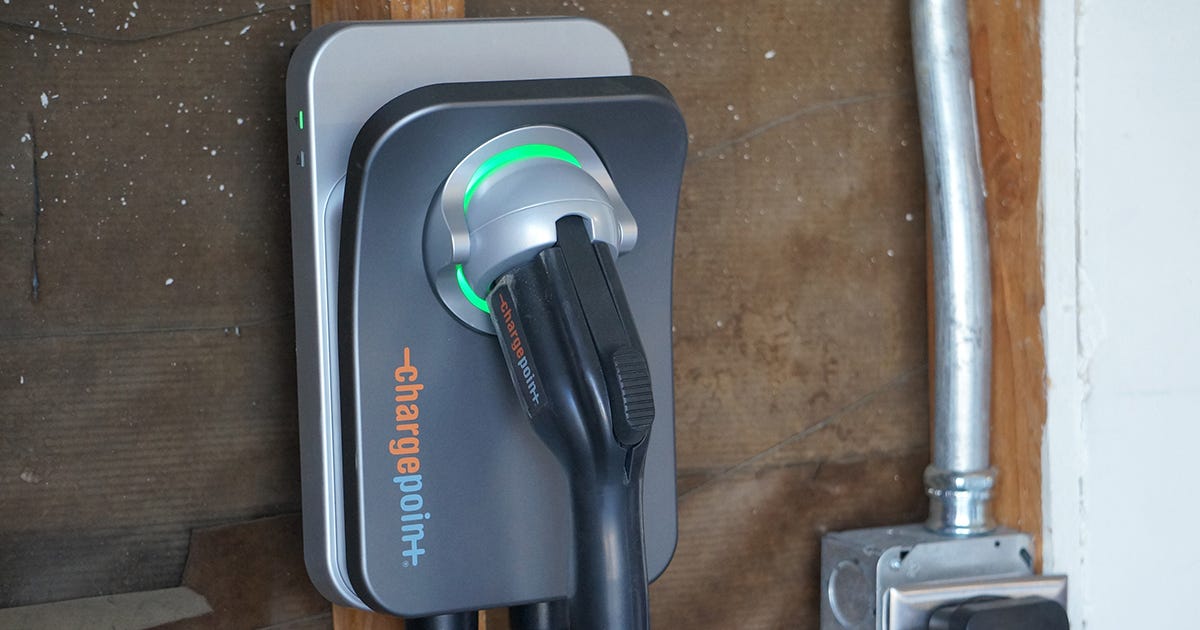Installing An EV Charger At My House Was Easy

Installing an EV Charger at My House Was Easy
With more and more electric vehicles coming through our test fleet -- including our long-term 2022 Mini Cooper SE -- I decided it was time to install a home charger. It's crucial for me because I live in a small desert town and the only public chargers are Level 2 units that deliver electricity at a super-slow speed of 8.3 kilowatts. The last thing I want to do is sit in the parking lot of the California Welcome Center for hours on end.
My first step was to look at my home's electrical panel and see if it could accommodate a Level 2 charger. I have a 100-amp panel and I want to charge at 50 amps, which should let me put 37 miles worth of juice back into the long-term Mini in about an hour. But I didn't want to have to upgrade my house to a 200-amp panel, which I thought I might need to do since I'd want to run things like the air conditioner at the same time.
The $699 ChargePoint Home Flex charger I bought can be set to a variety of amps, from 16 all the way up to 50. A good middle-ground charging speed is 40 amps, which puts about 30 miles of range back into the Mini each hour. Plus, by keeping the charging speed below 48 amps, I didn't need to have the charger hardwired to the house, which saved a few dollars during installation, and I didn't have to upgrade to the 200-amp panel. It's good to know that, if I'm hit with a heat wave, I can set the charger's amps lower and still crank the air conditioning.
With our long-term Mini Cooper SE's small battery, home charging is a must.
Emme Hall/CNETWhat I like best about my ChargePoint charger is the app. I can use it to find public charging stations when I'm out and about, but I can also use it to schedule my home charging schedule, set reminders, check on charging activity and adjust the amperage remotely.
My local electrician installed the ChargePoint L2 charger for right around $2,000. That included running conduit from the panel in the back of the house under the eave of my home and into the garage, pulling wire through said conduit and then installing a junction box and wiring up the charger. My electrician also added a 240-volt box for a future welder I want to purchase, so I probably could've saved some money if I hadn't asked for that extra work.
Just as there are incentives for buying an electric vehicle, there are also incentives for installing a home charger. The ChargePoint website has a handy search function so you can find rebates in your state. Unfortunately, my utility company and my county in California don't participate. Maybe you'll have better luck.
Not everyone can install a charger at home; renters definitely don't all have this luxury. But having the home charger has improved my time with the Mini, especially since it has a tiny 32.6-kilowatt-hour battery pack that gets an EPA-estimated 114 miles of range. In our testing, we've been seeing anywhere between 110 and 115 miles, but for me, that's one trip into Los Angeles. Having a charger at home -- especially one with an app like ChargePoint's -- means I can plug in and charge when it's most convenient. No more waiting around in the parking lot.
Source
Tags:
- Installing An Ev Charger At My House Was Easy E A
- Installing An Ev Charger At My House Was Easyjet
- Installing An Ev Charger At My House Was Built
- How To Install An Ev Charger At Home
- Can I Install An Ev Charger At Home
- Installing An Ev Charger Outlet
- Do I Need A Permit To Install An Ev Charger
- Installing An Evenflo Car Seat
- Installing An Electric Fireplace
- Installing An Above Ground Pool
